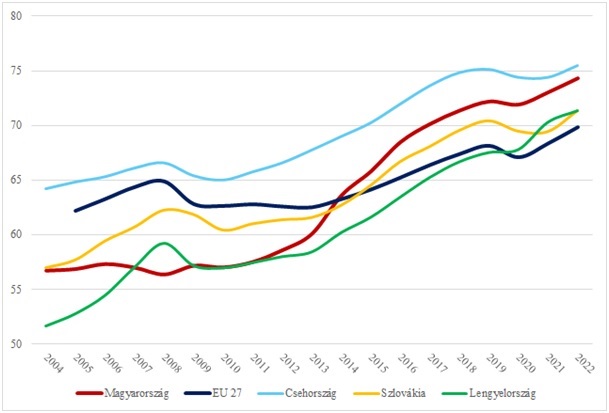Why are there so many more Hungarian people in work since we joined the EU?
According to the HCSO, between 2004 and 2023, the number of people in employment increased by nearly 824 thousand, an increase of 21%. The majority of the increase is accounted for by graduates and school leavers, while the number of skilled, unskilled and semi-skilled workers has decreased. The latest article in GKI's series of articles entitled "Hungary 20 years into the EU" also reveals the reasons for this large increase.

On 1 May 2004, ten new countries joined the European Union (EU), including Hungary. In a series of articles published by GKI Economic Research Zrt., experts examine how Hungary's situation has changed over the 20 years of EU membership, with the help of a series of indicators. Previous articles in the series have looked at Hungarian labour costs andchanges in pensions, while this article focuses on changes in employment.
In 2004, the employment rate in Hungary for the 15-64 age group was 56.8%. By 2022, this has risen to 74.4%, a quite remarkable increase of 17.6 percentage points. However, the change in the employment rate was not uniform: between 2004 and 2010 it was essentially 57%, but then started to rise rapidly from the early 2010s. In 2020, there was a very slight drop (much lower than the EU average) due to redundancies caused by the age crisis, but then the rate started to rise again.
Employment rates in the V4 countries and the EU (%)

Format: OECD
Employment rates in both the EU and the V4 countries plummeted between 2008 and 2010, before from the middle of the decade onwards, employment levels in the EU have steadily improved. Overall, the Visegrad countries have performed very well on this indicator, with all four countries outperforming the EU average by 2022.
Our country's performance is outstanding at both regional and EU level.In 2011 we outperformed the Poles, in 2014 the Slovaks and the EU average. Our gap of 7.4 percentage points with the Czechs in 2004 was reduced to 1 percentage point in 2022. In the same year, the average EU employment rate was already 4.6 percentage points higher than the Hungarian one (3.6% without public employment).
The employment rate for the 30-54 age group is 87-90%. For the 55-59 age group it is 82.3% (the impact of the Women40 programme is already here), and then for the 60-64 age group the rate drops to 54.8% (mainly due to retirement). The rate for the under-24s (20-24: 48.7%, 15-19: 5.6%) is low, but this is due to participation in secondary and tertiary education.
According to the KSH, between 2004 and 2023, the number of employed persons increased by nearly 824,000, an increase of 21%. The majority of the increase is accounted for by graduates ( 687 thousand people), but there has also been a significant increase in the number of people with a school leaving certificate ( 339 thousand people). Meanwhile, the number of employed decreased in the number of skilled workers (-101 thousand people) and in the number of people with only primary education, typically assistant and unskilled workers (-103 thousand people).
From 2010 to 2023, the number of workers increased by 32 thousand in agriculture and by 116 thousand in construction. In manufacturing, the number of people employed increased by 227 thousand between 2010 and 2018, and decreased by 51 thousand between 2018 and 2023.The largest increase was in the services sector, where 539 thousand more people are employed today than in 2010.
What is the reason for the rapid rise?
There are several reasons for the rise in employment levels. On the one hand, the domestic economyhas expanded significantly over the past two decades, which in itself has had a positive impact on the labour market. On the other hand, the economy has become largely white, with an increasing number of undeclared workers. In addition, the government has reduced taxes on labour, subsidised the public works programme and dual training (where apprentices are considered workers from the age of 16). Paradoxically, the 350-400,000 people who have emigrated since 2010 have also contributed to the positive numbers.Partly because the indicators include them (as they have typically retained their nationality), and partly because the missing labour force could only be filled at higher wages, which also attracted the previously inactive.
photo: freepik

